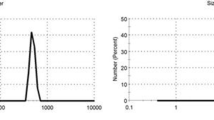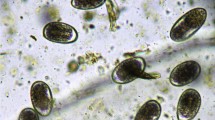Abstract
Coccidiosis and helminthosis in poultry are responsible for worldwide economic losses. The methanolic extract of Punica granatum (pomegranate) peel was used in vivo for its pharmacological, antioxidant and anti-coccidial properties and in vitro for its anthelmintic activity. For the in vivo study, four groups of mice were investigated. The first group was inoculated only with sterile saline and served as the control group. The second group was treated by oral gavage with pomegranate extract (300 mg/kg) daily for 5 days. The third and fourth groups were infected with 103 sporulated oocysts of Eimeria papillata. The fourth group was also treated once daily with pomegranate peel extract for 5 days. For the in vitro study, the anthelmintic effect of pomegranate peel extract was observed on live adult Allolobophora caliginosa. Paraffin sections from jejunum as well as jejunal homogenate were prepared for the histopathological and biochemical investigations, respectively. The data showed that mice infected with E. papillata revealed an output of approximately 2.9 × 105 oocysts per gram faeces on day 5 p.i. This output is significantly decreased to 50 % in pomegranate-treated mice. Infection with E. papillata induced marked histopathological alterations in jejunum in the form of inflammation, vacuolation of the epithelium and destruction of some villi. In addition, pomegranate extract caused a great diminish in body weight loss of infected mice. Moreover, the number of goblet cells stained with Alcian blue within the infected villi was significantly increased by about 26 % after pomegranate treatment. In addition, Pomegranate significantly lowered the increased number of apoptotic cells due to E. papillata infection by about 36 %. The results showed that E. papillata enhanced hydrogen peroxide, lipid peroxidation and nitric oxide production with concomitant reduction in glutathione. Pomegranate induced marked improvements in all of the studied parameters as well as the histopathological features of jejunum. In addition, pomegranate was able to exert a significant anthelmintic effect on live adult A. caliginosa worms in terms of the paralysis and death of the worms at different concentrations (100, 200 and 300 mg/ml). The study revealed that pomegranate as a natural product has protective effects against E. papillata-induced coccidiosis as well as it possesses an anthelmintic activity.





Similar content being viewed by others
References
Abdallahi OM, Hanna S, De Reggi M, Gharib B (1999) Visualization of oxygen radical production in mouse liver in response to infection with Schistosoma mansoni. Liver 19:495–500
Abdel Moneim AE (2012) Evaluating the potential role of pomegranate peel in aluminum-induced oxidative stress and histopathological alterations in brain of female rats. Biol Trace Elem Res 150:328–336
Abdel-Ghaffar F, Semmler M, Al-Rasheid KA, Strassen B, Fischer K, Aksu G, Klimpel S, Mehlhorn H (2010) The effects of different plant extracts on intestinal cestodes and on trematodes. Parasitol Res 108:979–984
Ajaiyeoba EO, Onocha PA, Olarenwaju OT (2001) In vitro anthelmintic properties of Buchholzia coriacea and Gynandropsis gynandra extract. Pharm Biol 39:217–20
Allen A, Hutton DA, Leonard AJ, Pearson JP, Sellers LA (1986) The role of mucus in the protection of the gastroduodenal mucosa. Scand J Gastroenterol Supp 125:71–78
Al-Mathal EM, Alsalem AM (2012) Pomegranate (Punica granatum) peel is effective in a murine model of experimental Cryptosporidium parvum. Exp Parasitol 131:350–357
Al-Quraishy S, Delic D, Sies H, Wunderlich F, Abdel-Baki AA, Dkhil MA (2011) Differential miRNA expression in the mouse jejunum during garlic treatment of Eimeria papillata infections. Parasitol Res 109:387–394
Arun N, Singh DP (2012) Punica granatum: a review on pharmacological and therapeutic properties. Int J Pharma Sci Res 3:1240–1245
Aviram M, Volkova N, Coleman R, Dreher M, Reddy MK, Ferreira D, Rosenblat M (2008) Pomegranate phenolics from the peels, arils, and flowersare antiatherogenic: studies in vivo in atherosclerotic apolipoprotein e-deficient (E 0) mice and in vitro in cultured macrophages and lipoproteins. J Agr Food Chem 56:1148–1157
Awad NE (2004) Bioactive brominated diterpenes from the marine red alga Jania Rubens (L.) Lamx. Phytother Res 18:275–279
Berkels R, Purol-Schnabel S, Roesen R (2004) Measurement of nitric oxide by reconversion of nitrate/nitrite to NO. Methods Mol Biol 279:1–8
Calzada F, Yepez-Mulia L, Aguilar A (2006) In vitro susceptibility of Entamoeba histolytica and Giardia lamblia to plants used in Mexican traditional medicine for the treatment of gastrointestinal disorders. J Ethnopharmacol 108:367–370
Cheng H (1974) Origin, differentiation and renewal of the four main epithelial cell types in the mouse small intestine. II. Mucous cells. Am J Anat 141:481–501
De Pablos LM, SantosMFB D, Montero E, Garcia-Granados A, Parra A, Osuna A (2010) Anticoccidial activity of maslinic acid against infection with Eimeria tenella in chickens. Parasitol Res 107:601–614
Dell’Agli M, Galli G, Corbett Y, Taramelli D, Lucantoni L, Habluetzel A, Maschi O, Caruso D, Giavarini F, Romeo S, Bhattacharya D, Bosisio E (2009) Antiplasmodial activity of Punica granatum L. fruit rind. J Ethnopharmacol 125:279–285
Deplancke B, Gaskins HR (2001) Microbial modulation of innate defense: goblet cells and the intestinal mucus layer. Am J Clin Nutr 73:1131S–1141S
Dkhil MA, Al-Quraishy S (2012) Metabolic disturbance and hepatic tissue damage induced by Eimeria papillata infection. Afr Zool 47:255–260
Dkhil MA, Abdel-Baki AS, Wunderlich F, Sies H, Al-Quraishy S (2011) Anticoccidial and antiinflammatory activity of garlic in murine Eimeria papillata infections. Vet Parasitol 175:66–72
Dkhil MA, Al-Quraishy S, Abdel Moneim AE, Delic D (2013) Protective effect of Azadirachta indica extract against Eimeria papillata-induced coccidiosis. Parasitol Res. doi:10.1007/s00436-012-3109-1
Dommels YE, Butts CA, Zhu S, Davy M, Martell S, Hedderley D, Barnett MP, McNabb WC, Roy NC (2007) Characterization of intestinal inflammation and identification of related gene expression changes in mdr1a(−/−) mice. Genes Nutr 2:209–223
Ellman GL (1959) Tissue sulfhydryl groups. Arch Biochem Biophys 82:70–77
Fernandes RM, Rodrigues MLA, Borba HR, Fernandes MZCM, de Amorim A (2004) Ausência da atividade anti-helmíntica de plantas em frangos de corte naturalmente infectados com Heterakis gallinarum (Schranck,1788) Madsen, 1949. Cienc Rural 34:1629–1682
Fossati P, Prencipe L, Berti G (1890) Use of 3,5-dichloro-2-hydroxybenzenesulfonic acid/4-aminophenazone chromogenic system in direct enzymic assay of uric acid in serum and urine. Clin Chem 26:227–231
Hammond JA, Fielding D, Bishop SC (1997) Prospects for plant anthelmintics in tropical veterinary medicine. Vet Res Commun 21:213–228
Harper GC, Makatouni A (2002) Consumer perception of organic food production and farm animal welfare. Br Food J 104:287–299
Klimpel S, Abdel-Ghaffar F, Al-Rasheid KAS, Aksu G, Fischer K, Strassen B, Mehlhorn H (2011) The effects of different plant extracts on nematodes. Parasitol Res 108:1047–1054
Korayem AM, Hasabo SA, Ameen HH (1993) Effects and mode of action of some plant extracts on certain plant parasitic nematodes. Anz Schadl 66:32–36
Linh BK, Hayashi T, Horii Y (2009) Eimeria vermiformis infection reduces goblet cells by multiplication in the crypt cells of the small intestine of C57BL/6 mice. Parasitol Res 104:789–794
Luder CGK, Gross U, Lopes MF (2001) Intracellular protozoan parasites and apoptosis: diverse strategies to modulate parasite–host interactions. Trends Parasitol 17:480–486
MacDonald TT, Monteleone G (2005) Immunity, inflammation, and allergy in the gut. Science 307:1920–1925
Mehlhorn H (ed) (2008) Encyclopedic reference of parasitology, vol 1, 3rd edn. Springer, Berlin
Mehlhorn H, Al-Quraishy S, Al-Rasheid KAS, Jatzlau A, Abdel-Ghaffar F (2011) Addition of a combination of onion (Allium cepa) and coconut (Cocos nucifera) to food of sheep stops gastrointestinal helminthic infections. Parasitol Res 108:1041–1046
Metwaly MS, Dkhil MA, Al-Quraishy S (2012) The potential role of Phoenix dactylifera on Eimeria papillata-induced infection in mice. Parasitol Res 111:681–687
Murugamani V, Raju L, Anand Raj VB, Sarma Kataki M, Sankar GG (2012) The new method developed for evaluation of anthelmintic activity by housefly worms and compared with conventional earthworm method. ISRN Pharmacol 2012:709860. doi:10.5402/2012/709860
Negi PS, Jayaprakasha GK, Jena BS (2003) Antioxidant and antimutagenic activities of pomegranate peel extracts. Food Chem 80:393–398
Ohkawa H, Ohishi N, Yagi K (1979) Assay for lipid peroxides in animal tissues by thiobarbituric acid reaction. Anal Biochem 95:351–358
Pai V, Chanu TR, Chakraborty R, Raju B, Lobo R, Ballal M (2011) Evaluation of the antimicrobial activity of Punica granatum peel against the enteric pathogens: an in vitro study. Asian J Plant Sci Res 1:57–62
Potten CS (1997) Epithelial cell growth and differentiation. II. Intestinal apoptosis. Am J Physiol 273:253–257
Pradhan KD, Thakur DK, Sudhan NA (1992) Therapeutic efficacy of Punica granatum and Cucurbita maxima against clinical cases of nematodiasis in calves. Indian J Indigenous Med 9:53–55
Salvemini D, Cuzzocrea S (2002) Superoxide, superoxide dismutase and ischemic injury. Curr Opin Investig Drugs 3:886–895
Schito ML, Barta JR, Chobotar B (1996) Comparison of four murine Eimeria species in immunocompetent and immunodeficient mice. J Parasitol 82:255–262
Toulah FH, Ismeel HA, Khan S (2010) Effect of treatment with Neem (Azadirachta indica) compared with Baycox drug on the caecum of chicken experimentally infected with Eimeria tenella. J Egypt Soc Parasitol 40:93–106
Vaux DL, Strasser A (1996) The molecular biology of apoptosis. Proc Natl Acad Sci USA 93:2239–2244
Yadav AK (2012) In vivo anthelmintic activity of Clerodendrum colebrookianum Walp., a traditionally used taenicidal plant in Northeast India. Parasitol Res 111:1841–1846
Yunus M, Horii Y, Makimura S, Smith AL (2005) Murine goblet cell hypoplasia during Eimeria pragensis infection is ameliorated by clindamycin treatment. J Vet Med Sci 67:311–315
Acknowledgment
The authors appreciate the Distinguished Scientist Fellowship Program, King Saud University, Saudi Arabia for funding this work.
Author information
Authors and Affiliations
Corresponding author
Rights and permissions
About this article
Cite this article
Dkhil, M.A. Anti-coccidial, anthelmintic and antioxidant activities of pomegranate (Punica granatum) peel extract. Parasitol Res 112, 2639–2646 (2013). https://doi.org/10.1007/s00436-013-3430-3
Received:
Accepted:
Published:
Issue Date:
DOI: https://doi.org/10.1007/s00436-013-3430-3








